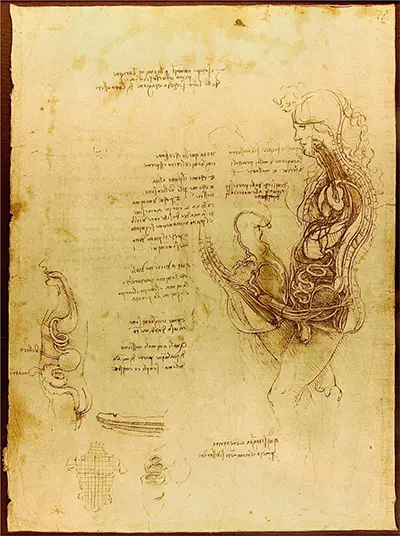However, da Vinci took an entirely new approach to this subject. As opposed to relying upon the cloak of mystery, he chose instead to physically break down and dissect the human for into its constituent parts.
This resulted in a highly detailed understanding of the human anatomy and as a result, the entire medical sector was given a boost.
One lesser-known and yet incredibly detailed work is Coition of a Hemisected Man and Woman. What can this sketch tell us about da Vinci and what are some of its most striking aspects?
An Understanding of the Human Anatomy
This first observation should come as no great surprise. Other sketches depicting the skull, detailed musculature and even an infant within the womb were all produced by this prolific artist.
However, this image is unique due to the fact that it was the only one which depicted humans engaging in coitus (hence the name). This was also quite revolutionary for a time partially defined by reserved forms of art and the pervasive influence of the church over the artists themselves.
Perhaps one of the reasons why the work was accepted was due to the fact that there are no romantic or emotional flavours found within its lines. Indeed, it would look just as appropriate within a contemporary textbook as it would within the works of da Vinci. We can clearly see images of all of the major organs, the spinal cord, the digestive tract and reproductive area of the male and female.
The accuracy involved is stunning and this also illustrates the common use of corpses in order to aid artist in their accurate depiction of the human anatomy.
More Than Copulation
There is no doubt that Leonardo da Vinci was a pragmatic man. A considerable portion of his life was spent exploring the practicality of inventions and similar engineering ventures.
This is why a specific element within Coition of a Hemisected Man and Woman warrants attention. We can note a wavy line immediately behind and above the head of the man in the image. We would first assume that this could have been a production error and that perhaps da Vinci had first intended the figure to be a woman.
However, this is not the case. This addition clearly suggests that da Vinci may have partially embraced the traditional view that the man transfers his essence (his spirit) to the woman along with the sperm. Still, it should be noted that the artist himself appeared to be sceptical of this belief later in life.
It nonetheless shows that even a man such as da Vinci was still influenced by esoterica; not entirely unrealistic when we consider the time when he lived.
The Scientific Edge
Leonardo da Vinci surely illustrates his talents as a multi-faceted artist within this sketch. Not only is it anatomically correct, but the piece clearly highlights the fact that he was remarkably ahead of his time in regards to science and medicine.
However, we should not mistake this objective undertaking for a lack of emotion.
Leonardo da Vinci was a deeply passionate man and he embraced this very same human quality in countless other works through his respected career.


